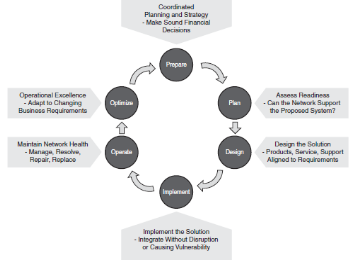1.6. 2.5.2 Top-Down Network Design Methodology
Top-down network design is a methodology for designing
networks that begins at the upper layers of the OSI reference model before
moving to the lower layers. It focuses on applications, sessions, and data
transport before the selection of routers, switches, and media that operate at
the lower layers. The top-down network design process includes exploring
divisional and group structures to find the people for whom the network will
provide services and from whom you should get valuable information to make the
design succeed.
1.7. 2.5.3 Plan, Design, Implement, Operate, and Optimize
(PPDIOO) methodology
The network design methodology presented in this section is
derived from the Cisco Prepare, Plan,
Design, Implement, Operate, and Optimize (PPDIOO) methodology,
which reflects a network's lifecycle. The following sections describe the
PPDIOO phases and their relation to the network design methodology, and the
benefits of the lifecycle approach to network design. Subsequent sections
explain the design methodology in detail.

Figure 2.3. PPDIOO Network Lifecycle Influences
Design
The following describes each PPDIOO phase:
Prepare phase: The Prepare phase involves
establishing the organizational (business) requirements, developing a network
strategy, and proposing a high-level conceptual architecture, identifying
technologies that can best support the architecture. Financial justification
for the network strategy is established by assessing the business case for the
proposed architecture.
Plan phase: This phase involves identifying the
network requirements, which are based on
the goals for the network, where the network will be installed,
who will require which network services, and so forth. The Plan phase also
involves assessing the sites where the network will be installed and any
existing networks, and performing a gap analysis to determine if the existing
system infrastructure, sites, and operational environment can support the
proposed system. A project plan helps manage the tasks, responsibilities,
critical milestones, and resources required to implement the changes to the
network. The project plan should align with the scope, cost, and resource
parameters established in the original business requirements. The output of
this phase is a set of network requirements.
Design phase: The initial requirements
determined in the Plan phase drive the network design specialists' activities.
These specialists design the network according to those initial requirements,
incorporating any additional data gathered during network analysis and network
audit (when upgrading an existing network) and through discussion with managers
and network users. The network design specification that is produced is a
comprehensive detailed design that meets current business and technical
requirements and incorporatesspecifications to support availability,
reliability, security, scalability, and performance. This design specification
provides the basis for the implementation activities.
Implement phase: Implementation and
verification begins after the design has been approved. The network and any
additional components are built according to the design specifications, with
the goal of integrating devices without disrupting the existing network or
creating points of vulnerability.
Operate phase: Operation is the final test of
the design's appropriateness. The Operate phase involves maintaining network
health through day-to-day operations, which might include maintaining high
availability and reducing expenses. The fault detection and correction and
performance monitoring that occur in daily operations provide initial data for
the network lifecycle's Optimize phase.
Optimize phase: The Optimize phase is based on
proactive network management, the goal of which is to identify and resolve
issues before real problems arise and the organization is affected. Reactive
fault detection and correction (troubleshooting) are necessary when proactive
management cannot predict and mitigate the failures. In the PPDIOO process,
the
| 


